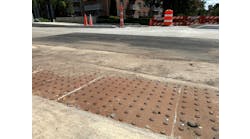Six hundred fifty people lost their lives in 2007 on Arkansas roadways. That is a number the Arkansas State Highway and Transportation Department (AHTD) believes is too high.
Since that time, a number of measures have been implemented to reduce motor vehicle fatalities. Today Arkansas has a statewide trauma system, graduated driver’s license laws, primary seat belt laws and many additional safety improvements to Arkansas’ highway infrastructure. A radio and television campaign was recently placed into the mix as well.
As a result, the number of roadway fatalities in Arkansas decreased to 551 in 2011, a 15% decrease in four years. The fatality rate on Arkansas roadways decreased to 1.67 deaths per 100 million vehicle-miles traveled, surpassing the previous goal of 1.8 by the year 2010.
Despite those accomplishments, Arkansas had the second highest traffic fatality rate in the nation in 2010.
In 2012, the Arkansas Highway Safety Steering Committee began the process of updating the state’s Strategic Highway Safety Plan. A Safety Summit was convened in 2012 that brought experts and local professionals together to help shape the plan.
It was decided the focus of the 2013 Strategic Highway Safety Plan should be “Toward Zero Deaths.” Since 2001, approximately 30 states have shared that vision and adopted a national Toward Zero Deaths mission to reduce fatal traffic crashes to zero.
What does the plan mean for the AHTD and Arkansas’ highways? What changes can be made to improve safety?
To reach this goal, the State Highway Safety Plan identified key safety areas and high-payoff strategies.
This cable just in
In 2010, 63% of all roadway fatalities in Arkansas involved a roadway-departure crash. A roadway-departure crash is defined as a nonintersection crash that occurs when a vehicle crosses the edge line, the centerline or otherwise leaves the travel lane. Today, safety features are springing up on highways all across the state to reduce this type of crash.
In 2013, the AHTD adopted a new cable median barrier policy. The barriers are designed to reduce the chances of vehicles crossing the median into oncoming traffic.
“Motorists can expect to see considerably more cable median barriers being installed across the state,” said AHTD Director Scott Bennett.
Cable median barriers will be installed on about 400 miles of Arkansas’ freeways and expressways over a three-year period, bringing the statewide total to more than 500 miles by the end of 2016. It is projected that cable median barriers will save the lives of at least 10 people per year statewide once installed.
A before-and-after safety analysis of two projects that installed cable median barriers along I-40 and I-55 in Arkansas has revealed a significant reduction in fatal median crossover crashes. The I-40 project location, located between Biscoe and Brinkley, had 10 fatal crashes in the 36 months before a cable median barrier was installed. In the 36 months after installation, the number of fatal crashes at the location dropped to zero. On I-55, the number of fatal crashes dropped from two to zero after installation of a cable barrier. This substantiates multiple studies nationwide that report similar results.
“It has been determined that cable median barriers are a highly cost-effective way to reduce the number and severity of median crossover crashes,” Bennett said. “The objective of this new program to enhance safety and provide additional protection on our highways is definitely working.”
Wake-up buzz
Fatalities related to distracted driving, particularly texting, are a growing concern in Arkansas and across the country. Distracted driving is considered as any activity that could divert a person’s attention away from the task of driving and lead them to leave the roadway. There were 34 fatalities in the state that involved a distracted or drowsy driver in 2010.
Rumble strips are an effective countermeasure for preventing roadway-departure crashes. The noise and vibration produced by rumble strips alert drivers when they are leaving the travel lane. Centerline rumble strips and shoulder rumble strips are now becoming permanent features on Arkansas’ highways.
It has been estimated that 40-60% of run-off-the-road crashes are due to driver fatigue, drowsiness or inattention. Many studies of the effectiveness of shoulder rumble strips indicate that they can reduce overall crashes by 14-17%. Shoulder rumble strips have been documented to reduce run-off-the-road crashes by 7-41%. Centerline rumble strips may reduce head-on crashes by 21-68%.
Arkansas has installed more than 1,000 miles of rumble strips on its highways to date. In 2009, the AHTD received a safety award from the Federal Highway Administration (FHWA)and the Roadway Safety Foundation for an innovative project that placed rumble strips on the centerline of Highway 7 in north-central Arkansas. Because Highway 7 runs through a mountainous area of the Ozark National Forest, many horizontal and vertical curves exist. Before-and-after crash analysis conducted on the 74-mile stretch of highway showed a significant reduction in fatal and injury crashes.
“Rumble strips will continue to play a major role in the design of our highways in the years ahead,” Bennett said, “as we strive to build safer highways.”
High sticking
A new pavement treatment the AHTD has been using on its interstates to reduce wet-weather crashes is now being modified for application on some noninterstate highways with the hopes of achieving the same results: a reduction in traffic accidents and fatalities caused by hydroplaning.
Application of the thin coating on the road surface provides a texture that will drain more water than a typical surface and increase skid resistance.
The treatment is part of a FHWA-backed initiative that focuses on critical locations such as curves in roadways. Curves make up 5% of the nation’s highways but account for 25% of fatalities on those highways.
In Arkansas, the AHTD has applied the treatment at six locations on I-30, I-40 and I-440. Now the technique is going to be used on additional roadways.
“The epoxy coating that will be used on the state’s other roadways will increase abrasiveness and will aid in braking and control of a vehicle,” said Randy Ort, AHTD public information officer.
Approximately 25 locations on noninterstate highways in Arkansas will receive the new treatment in the near future.
Cross one off the list
In 2012, 51 crashes in Arkansas involved a motor vehicle and a train. Although only approximately 1% of all roadway fatalities in Arkansas involve a train, railroad crossings still present serious safety concerns and are a crucial component of the Toward Zero Deaths campaign.
There are currently 2,463 public at-grade railroad crossings in Arkansas, 413 of which are on the state highway system. Of those crossings, 866 are actively protected (crossings where an oncoming train activates flashing lights and possibly gates). The remaining 1,597 public at-grade crossings are passively protected with cross-buck signs only.
A decrease in crashes from 20 years ago can be attributed to the Railway-Highway Crossing Program (RHCP), which is a federal-aid program administered under the FHWA and participated in by AHTD.
There are three primary improvements that can be done through the RHCP at existing railroad crossings: an upgrade of traffic control devices, replacement of at-grade crossings with a railroad overpass or closure of the crossing.
The most common project consists of the installation of flashing lights with gates. The AHTD typically coordinates 10 to 20 such safety crossing improvement projects each year with railroads as part of the RHCP.
The department also addresses railroad-crossing safety through other means. The AHTD participates with Operation Lifesaver, a non-profit organization providing public-education programs to address safety on railroads and railroad crossings. Operation Lifesaver sponsors several Highway-Railway Grade Crossing Collision Investigation courses in Arkansas each year where local law enforcement officers and emergency responders are trained in proper procedures for reacting to railroad crossing crashes.
The AHTD also deals with crossing issues related to train blockages and crossing surfaces, which can be safety concerns. Blocked crossings can impede emergency-vehicle access to certain neighborhoods, while rough crossings (or crossings with a hump) can hinder certain vehicles from crossing.
Although significant improvements to railroad-crossing safety have been made in Arkansas in recent years, there is more work to be done. Addressing railroad-crossing safety is one more effort to bring Arkansas one step closer Toward Zero Deaths. New strategies call for continued safety improvements at existing at-grade railroad crossings by adding lights and gates, improving sight distance, improving signing to current standards and improving signal pre-emption. In addition, the AHTD will work to encourage local jurisdictions to reduce the number of at-grade crossings.
Toward a common vision
The AHTD joined with other state agencies in March of this year in an aggressive new statewide TZD campaign. Joining the AHTD are the Arkansas State Police and the Arkansas Department of Health. By uniting many groups under a common vision, it is believed that the country can pursue a culture of safety and reduce highway fatalities at a much faster rate.
The TZD campaign will use data to target areas for improvement and employ proven countermeasures through education, enforcement, engineering and emergency-services strategies.
“We are the engineering component of this effort to work toward an overarching goal of making major reductions in roadway fatalities,” Bennett said. “The Highway and Transportation Department tackles engineering challenges every day to make our roadways safer. Improvements such as median cable barriers and rumble strips are just the beginning. Our departments will now be working together on this critical initiative and promoting all aspects of road safety.”
The multiagency TZD campaign includes radio and television public-service announcements that are currently airing in the central Arkansas area.
“We are moving in the right direction,” Bennett added. “In 2013, we saw the lowest number of traffic deaths on Arkansas’ highways since 1961. That number was 490. That’s a 13% decrease compared to 2012. These organizations will work together for more improvements, because even one death is too many. This program will point all of us in the right direction.”
Approximately 30 states have adopted a TZD strategy. A recent study of four states that were early adopters of TZD (Washington, Idaho, Utah and Minnesota) showed a statistically significant decrease in roadway fatalities after a TZD strategy was adopted.
Arkansas can achieve its goals even with a rebound in the nation’s economy and an increase in vehicle-miles traveled. According to the National Highway Transportation Safety Administration (NHTSA), fatalities in the U.S. were 9% higher in 2013 than in the first six months of 2012. However, fatalities in Arkansas in 2013 dropped to 490, a decrease from 560 recorded in 2012. Arkansas is one of 11 states, according to the National Safety Council, that are continuing a downward trend compared with the same time period a year ago.
“This is a significant accomplishment,” Bennett concluded, “and the AHTD is determined to keep the momentum going.”
The Toward Zero Deaths program is supported by funding from the NHTSA and the FHWA. It is part of “Toward Zero Deaths: A National Strategy on Highway Safety,” developed by a national coalition of traffic safety groups as a more organized and comprehensive way to address highway safety. TM&E


